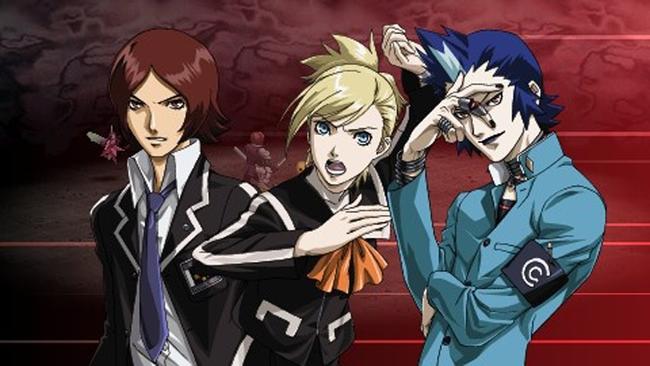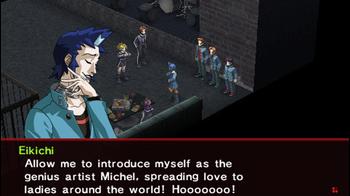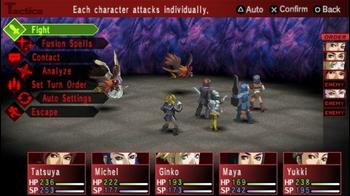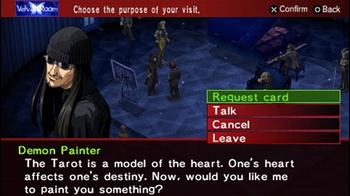
Shin Megami Tensei: Persona 2 - Innocent Sin Review
Just as Final Fantasy VII was responsible for propelling the series to mainstream appeal, so it can be stated that Persona 3 was responsible for putting the Shin Megami Tensei series in current gamers' radars. And like Final Fantasy, this newfound audience may be curious enough to check out the older games in the series, which is enough incentive for Atlus to re-release those classic cult titles in the hopes of gaining new recognition.

But rather than complain on an internet forum about how their favorite series are now terrible by virtue of becoming popular, hardcore gamers should instead be pleased that all the attention means localizing titles that were long exclusive to imports and fan translations. Such is the case with Persona 2: Innocent Sin, the first of a two-part sequel to the original Persona which remained exclusive to Japan for over ten years. North America only got half the story with the localization of the 2nd chapter (Eternal Punishment), while Europe was denied both games entirely. And while the PSP's upcoming death-knell may cast doubt on Eternal Punishment getting its own port, at least Persona's English-speaking fans now have an opportunity to experience Part One of the PSX duology.
Set after the events of the first Persona, Innocent Sin features a new cast and setting while also carrying over a sampling of both from the original. The story focuses on Tatsuya Suou, who carries the series tradition of silent protagonists while also classified as a distant loner at his school. Due to a series of events involving a rival school, Tatsuya and fellow classmate/girlfriend Lisa Silverman come across Persona-user Eikichi Mishina, which soon triggers the duo's own Personas. Before this discovery sinks in, the trio then comes face-to-face with Joker, a clown-garbed demon who allegedly grants peoples' wishes, but instead vows revenge against Tatsuya and the others over an incident that they have no recollection of.
Narrowly avoiding death, Tatsuya and company must now work together to stop the sinister wishes granted by Joker, including a curse affecting the students at his high school. Other Persona users, including the upbeat investigative reporter Maya and Persona 1 veteran Yukino, will assist the group as they use the power of the rumors to their advantage and to stop Joker's diabolical schemes.
Like the other Persona games, Innocent Sin's premise of high schoolers unraveling an occult mystery is intriguing while also staying grounded in reality, thanks to its modern-day Japan setting. But the pacing during its opening is a bit more uneven then the slow-paced setups of Persona 3 and 4, despite taking just as long to put players in charge. The characters come into acceptance about becoming Persona users far too casually, not to mention the existence of demons. If you can look past that, however, there is plenty of intriguing mysteries (such as why a good deal of students wear bandages, or why they also tend to both condemn and revere their principal under the same breath) that slowly unravel a story that keeps your interest with each passing hour (and goes fully off the rails when a certain fuhrer rears his non-exploded head).
The playable characters are also well portrayed and have many interactive moments, including lines of dialog for nearly every single are of the game that does not feature random battles. While Innocent Sin lacks the Social Link system that has now become a series standard, several NPC characters have an important role in the overarching plot as well. There are hardly any characters that remain static throughout the game, a testament to the series' strong focus on character development, but it's unfortunate that any voice acting is rare to the point that it's almost nonexistent.
Also unfortunate is how little effort Atlus has done to make the PSP version more accessible as a handheld title. Aside from a few minor touchups, the game's visuals remain unchanged as a sprite-based third person isometric game, similar to other PSX RPGs of that era such as Xenogears and Final Fantasy Tactics. Though this visual style is still sufficient today (minus the limited amounts of character animations), it's the overall structure of the dungeons and battles that encumber the portability of this re-release.
The dungeons typically consist of multi-floored corridors that offer little variety in their layout designs. While Persona 3 and 4 featured a similar problem, the difference here is that players are usually required to backtrack to and from the multiple floors, as well as enter interior rooms within each floor. Coupled with the random battles, the repetitive dungeon layouts will likely result in players getting lost in confusion. And while the mini-map does keep track of areas you've explored and haven't explored yet (by highlighting every part of the dungeon floor you step over), it doesn't list what each door leads to, requiring a photographic memory to find your way back to whichever room the plot directs you toward.
Speaking of the random battles, the game features the same menu-driven Persona-summoning battle system as its PS2 successors; party members can attack with their equipped weapons or summon their Persona to unleash an elemental-based attack, of which adheres to an enemy's specific weakness (some demons are weaker to fire, some to water, others by sword strikes or instant death spells, etc). Some key differences in Innocent Sin's mechanics include Personas gaining levels separately from their human hosts, Fusion spells in place of All-Out Attacks, and additional Personas gained by collecting a set number of tarot cards from fallen foes...or earning them through friendship.
As an exclusive to Persona 2, players have the ability to make peace with every random enemy by initiating contact with them. Once the option is selected, you can then choose which of the party members (or a combination of them) will initiate a conversation with the demon, each character possessing a specific personality trait (from Eikichi's singing to Lisa's sex appeal, for example) that will result in the demon eliciting a certain emotional response (happy, angry, scared or curious). Once a certain emotion is filled up, the demon will either want to continue the fight, run from battle, offer you a reward or offer to make a pact with you (which can lead to further rewards or rumors). It's a unique system filled with amusing responses, but the dialog during these conversations tend to repeat too often, and further prolong the battles when you fail to charm the targeted demon.
Also unique to Persona 2 is the rumor system; due to Joker's influence, rumors can manifest into reality if enough people believe in them. To take advantage of this, the party can hire a detective agency to take a rumor (which is usually first heard by an NPC) and spread it across town, while also adding in some extra details to bring it to life however you want. This can include opening up new shops or unlocking a new dungeon, just to name a few. Coupled with the quick-selecting interface that allows you to visit specific shops and areas through menus, navigating the NPC areas and gathering supplies is far quicker than the lengthy dungeons.
And if the extra quests weren't enough for you, there's also the Climax Theater, which allow players to partake in extra self-contained episodes involving new characters and dungeons to interact with. These extra scenarios are an interesting diversion from the main story, and also count toward the experience and items earned in the main game, but the one major catch is that you cannot save your progress, requiring players to play through the (occasionally lengthy) stories in one go. Furthermore, the option to allow players to create and share their own original storylines has been removed in the European and North American releases due to technical issues.
In the end, Persona 2 still holds up as a quality RPG that could have used a bit more streamlining and quick save features to adhere to its portable makeover. If you can get around its somewhat antiquated mechanics, you'll find a lengthy adventure brimming with content and a likeable cast of characters.


